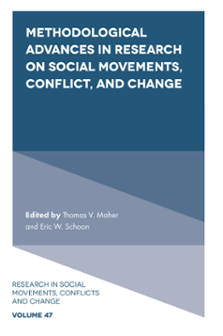
Index
Methodological Advances in Research on Social Movements, Conflict, and Change
ISBN: 978-1-80117-887-7, eISBN: 978-1-80117-886-0
ISSN: 0163-786X
Publication date: 12 July 2023
Citation
(2023), "Index", Maher, T.V. and Schoon, E.W. (Ed.) Methodological Advances in Research on Social Movements, Conflict, and Change (Research in Social Movements, Conflicts and Change, Vol. 47), Emerald Publishing Limited, Leeds, pp. 269-277. https://doi.org/10.1108/S0163-786X20230000047012
Publisher
:Emerald Publishing Limited
Copyright © 2023 Thomas V. Maher and Eric W. Schoon. Published under exclusive licence by Emerald Publishing Limited
INDEX
- Prelims
- Navigating Interests and Cultivating Innovation in the Study of Social Movements, Conflict, and Change
- Section I Innovations in Data Collection and Processing
- Beyond Protests: Using Computational Text Analysis to Explore a Greater Variety of Social Movement Activities
- The Use of Digitized Newspaper Archives for World-Historical Research on Social Conflicts: The State-Seeking Nationalist Movements Database
- Satellite Images in Conflict Research: Methodological and Ethical Considerations
- Instant Archives: Social Media and Social Movement Research
- Section II Epistemology and Reflexivity
- Moments of Interrogation: Doing Feminist Ethnography in the Archives
- Developing Ethical Standards for Student Participation in Protest Research
- Insider-Outsider Dynamics and Identity in Qualitative Studies of Social Movements
- Section III Novel Analytics
- How to Analyze the Influence of Social Movements With QCA: Combinational Hypotheses, Venn Diagrams, and Movements Making Big News
- Measuring Event Diffusion Momentum (EDM): Applications in Social Movement Research
- Coalitions Under Threat: Analyzing the 2019 Hong Kong Anti-Extradition Protests Using Telegram Social Media Data
- Index